Gravitation Class 9 Notes Science Chapter 9
| Table of contents |

|
| What is Gravitation? |

|
| Free Fall or Gravity |

|
| Mass |

|
| Weight |

|
| Thrust and Pressure |

|
| Archimedes’ Principle |

|
What is Gravitation?
Gravitation is a natural force that makes every object in the universe pull on every other object.
- This pulling force is called the force of gravitation.
- Although this force is quite weak and usually needs large masses to be noticeable, it can act over great distances.
- The law of gravitation applies to objects everywhere in the universe, making it a universal law.
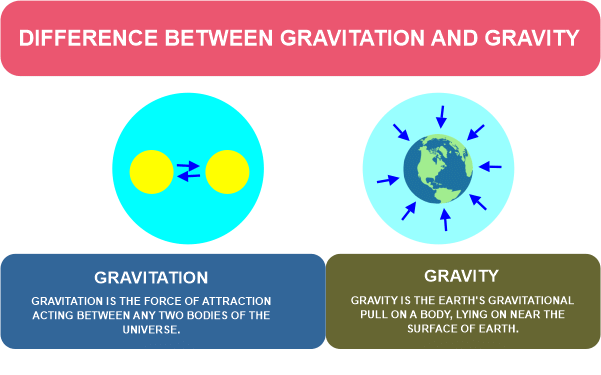
Centripetal Force
Centripetal force is what keeps objects moving in a circular path. It pulls objects towards the centre of the circle, helping them keep moving in that circular motion. The strength of this force depends on:
 Examples of Centripetal Force
Examples of Centripetal Force
- The speed of the object.
- The distance from the centre.
- The mass of the object.
When we say "centripetal," we mean moving towards the centre. The object's speed stays constant as it moves along the circular path, which is called tangential velocity.
There's a similar-sounding force called centrifugal force, but it actually makes things want to fly off in a straight line from the circle's center. People sometimes mix up centripetal and centrifugal forces.
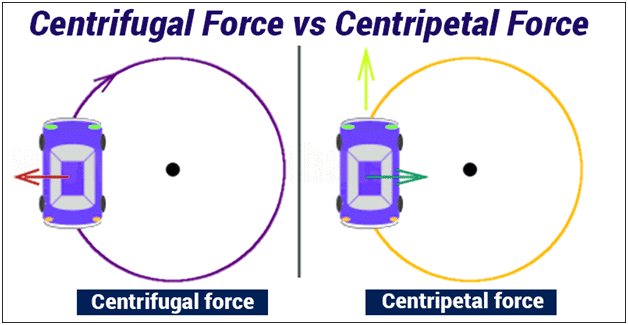
Universal Law of Gravitation
According to Newton’s law of gravitation, the force of gravitational attraction between two objects is directly proportional to the product of their masses and inversely proportional to the square of the distance between them.
This means:
- The gravitational force gets weaker as you go higher up.
- It also changes on the Earth's surface, becoming weaker from the poles to the equator.
Formula: If M and m be masses of two objects separated by a distance d, the gravitational force of attraction between them is given by:
F = G M m⁄d2 where G is a constant, known as the Universal constant of gravitation.
where G is a constant, known as the Universal constant of gravitation.
- The universal constant of gravitation G is numerically equal to the force of attraction between two objects of unit mass each separated by unit distance.
- The value of G is 6.673 x 10-11 N m2 kg-2. This value was determined by Henry Cavendish (1731 – 1810) using a sensitive balance.
- G is called a universal constant because its value does not depend on the nature of the intervening medium or temperature or any other physical variable.
- As the value of G is extremely small, the gravitational force between regular objects is so small that it cannot be detected.
- However, the force of attraction acting on an object due to Earth, the force of attraction between Earth and the moon, and the force experienced by planets due to the gravitational attraction of Sun can be easily felt and measured.
Example 1: Suppose we have two objects: Object A with a mass of 5 kilograms and Object B with a mass of 10 kilograms. The distance between the centers of these objects is 2 meters. We'll assume the gravitational constant, G, to be approximately 6.674 × 10-11 N m2/kg2.
Solution:
Using the Universal Law of Gravitation, we can calculate the gravitational force between these objects:
F = (G * (m1 * m2)) / r2
F = (6.674 × 10-11 N m2/kg2 * (5 kg * 10 kg)) / (2 m)2
F = (6.674 × 10-11 N m2/kg2 * 50 kg2) / 4 m2
F ≈ 8.3425×10 −10N
Therefore, the gravitational force between Object A and Object B is approximately 8.3425×10 −10 Newtons.
Importance Of The Universal Law Of Gravitation
The universal law of gravitation successfully explained several phenomena which were believed to be unconnected:
- The force that binds us to the Earth
- The motion of the moon around the Earth
- The motion of planets around the Sun
- The tides due to the moon and the Sun
Free Fall or Gravity
The force that pulls objects toward the Earth is known as the force of gravity.
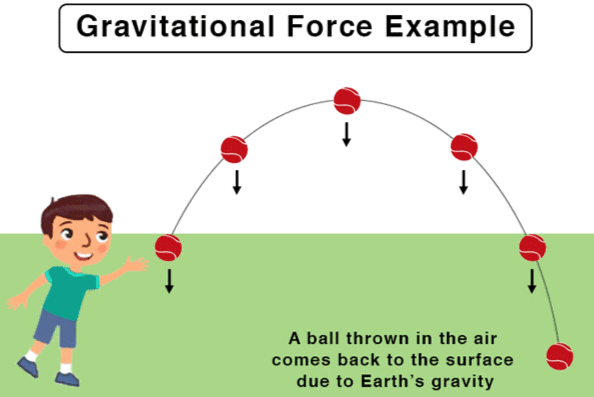
- For an object with mass m located on or near the Earth, this force can be calculated using the formula: F = GMm/R², where G is the universal gravitational constant, M is the mass of the Earth, and R is the radius of the Earth.
- The acceleration produced in a freely falling object on account of the force of gravity is known as the acceleration due to gravity. It is denoted by the symbol ‘g’.
 Gravitation Formula
Gravitation Formula
To Calculate the Value of g
The acceleration due to gravity at Earth's surface is given by the formula: g = GM/R². The average value of g on the surface of the Earth is about 9.8 m/s². To find g, we use these constants:
- G = 6.7 × 10-11 N m²/kg² (Gravitational Constant)
- M = 6 × 10 24 kg (Mass of the earth)
- R = 6.4 × 106 m (Radius of the earth)
- Here's how the value of g is calculated.
 Calculation of acceleration due to gravity
Calculation of acceleration due to gravity

The motion of Objects under the influence of Gravitational Force of the Earth
The value of g varies from place to place. On the surface of the earth value of g is more at the poles than at the equator. Again value of g decreases as one goes away and away from the earth.
 Free Fall Motion
Free Fall Motion
- When an object falls towards the earth under the force of gravity alone, we say that the object is in free fall. A freely falling object experiences a constant acceleration of g (=9.8ms-2) during its downward motion. However, if an object is projected vertically upward with a certain velocity, its velocity goes on decreasing due to gravity, till it comes to rest and then starts falling vertically downward under gravity.
- To demonstrate the impact of air resistance on falling objects, try this activity:
Activity: Drop a piece of paper and a stone from the same height at the same time. Check if both hit the ground together. You will notice that the paper takes longer to fall because of air resistance. In a vacuum, both would fall at the same speed.
- The three equations of motion viz, (i) v = u + at, (ii) s = ut + 1/2 at2, and (iii) v2 - u2 = 2as are true for motion of objects under gravity. For free fall, the value of acceleration a = g = 9.8ms-2.
- If an object is just let fall from a height then in that case u = 0 and a = +g = +9.8ms-2.
- If an object is projected vertically upwards with an initial velocity u, then a = -g = -9.8ms-2 and the object will go to a maximum height h where its final velocity becomes zero (i.e. v = 0). In such a case

Examples for the Three Equations of Motion Under Gravity
1. Using v = u+at:

2. Using s = ut + 1/2at2
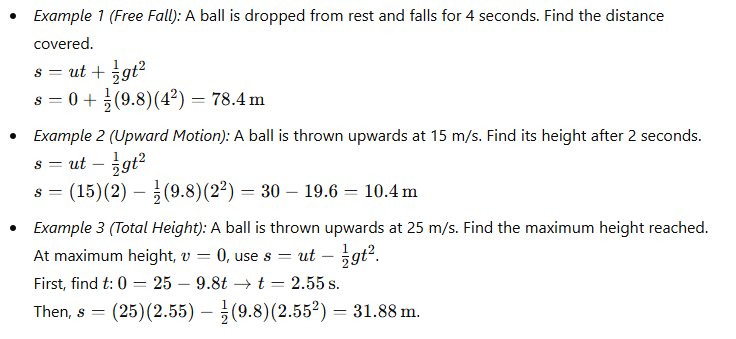
2. Using
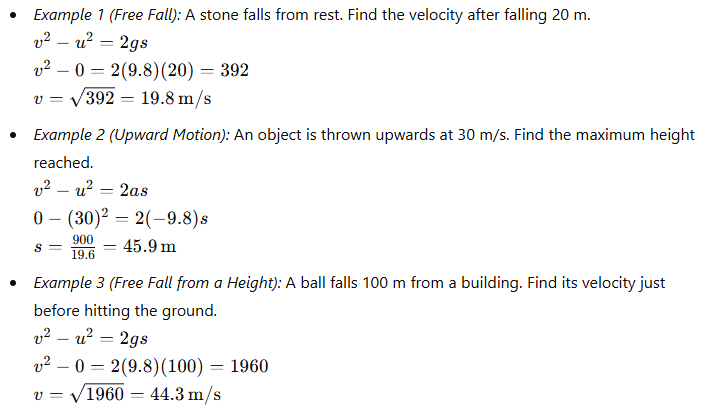
Mass
The mass of an object is a measure of its inertia. The mass of an object is constant and does not change from place to place. Mass and Weight
Mass and Weight
Weight
- The weight of an object is the force with which it is attracted towards the earth. Weight W of an object of mass m will be W = mg. Weight is a force acting vertically downwards. It means that it is a vector.
- As the weight of an object is a force, its SI unit is Newton (N).
An object of mass m = 1 kg has thus a weight of W = 1 x 9.8 = 9.8 N. - At a given place weight of an object is directly proportional to its mass t.e.,
 (at a given place). Due to this reason at a given place, we may use the weight of an object as a measure of its mass.
(at a given place). Due to this reason at a given place, we may use the weight of an object as a measure of its mass.
 |
Download the notes
Chapter Notes: Gravitation
|
Download as PDF |
Weight of Object on the Moon
- Mass of an object remains the same everywhere but weight of an object changes from place to place. For an object of mass m weight W is dependent on value of g.
- Force of gravity due to moon is 1/6th of the force of gravity due to earth.
Hence
Due to this very reason weight of an object on moon will be 1/6th of its weight on the earth.
Thrust and Pressure
The normal force acting on a surface, due to the weight of an object placed on the surface, is called ‘thrust’. As thrust is a sort of force hence its SI unit is “a newton” (N).
 Thrust
Thrust
- The thrust on unit surface area is called pressure.
Pressure
Thus, pressure on a given object is the normal force acting on its surface per unit surface area.
SI unit of pressure is N m-2 but it is also called pascal and denoted by symbol Pa.
∴ 1 pascal (1 Pa) = 1 N m-2 - Same force acting on a smaller area exerts a larger pressure. It is due to this reason that a nail or a pin has a pointed tip and knives have sharp edges.
- Given force acting on a larger area exerts a smaller pressure. It is due to this reason that foundations of houses are made broad, base of dams is made broad, sleepers are laid below the railway line and so on.
Pressure in Fluids
Fluid is that state of matter which can flow. All liquids and gases are fluids.
- As fluids have weight, they exert pressure on the base and the walls of the container in which they are kept.
- In a fluid, pressure applied at any one place is transmitted equally in all directions.
Buoyancy
- Whenever an object is immersed in a fluid, it experiences a force in the vertically upward direction due to that fluid. This force due to a fluid acting in upward direction is called ‘force of buoyancy’ or ‘buoyant force or up thrust.
 Buoyancy
Buoyancy
- Magnitude of force of buoyancy acting on an object depends upon
(i) the volume of an object immersed into the fluid, and
(ii) the density of the fluid. Due to force of buoyancy the net weight of an object becomes less than its normal weight.
Why Objects Float Or Sink When Placed On The Surface Of Water?
The ability of an object to float or sink when placed on the surface of water is determined by its density and the density of the water. Density is a measure of how much mass is contained in a given volume.
 Floating and Sinking on Surface of WaterWhen an object is placed in water, it experiences two main forces: buoyancy and gravity.
Floating and Sinking on Surface of WaterWhen an object is placed in water, it experiences two main forces: buoyancy and gravity.
- Buoyancy is the upward force exerted on an object immersed in a fluid (in this case, water). It is caused by the difference in pressure between the top and bottom of the object. The greater the volume of water displaced by the object, the greater the buoyant force. According to Archimedes' principle, an object will experience an upward buoyant force equal to the weight of the water it displaces. If the buoyant force is greater than the object's weight, it will float. If the buoyant force is less than the object's weight, it will sink.
- Gravity, on the other hand, is the downward force pulling the object toward the center of the Earth. The weight of the object depends on its mass and the acceleration due to gravity. If the weight of the object is greater than the buoyant force, it will sink. If the weight is less than the buoyant force, it will float.
In summary, whether an object floats or sinks in water depends on the comparison between its weight and the buoyant force exerted by the water. If the object's weight is greater, it will sink. If the buoyant force is greater, it will float.
Archimedes’ Principle
A Greek scientist Archimedes discovered a principle regarding buoyant force (or the loss in weight of an object when immersed in a fluid).
 Archimedes' Principle
Archimedes' Principle
- According to Archimedes’ principle “whenever an object is immersed fully or partially in a fluid, it experiences an upward force that is equal to the weight of the fluid displaced by it”.
- Alternately, according to Archimedes’ principle “there is always a loss (decrease) in weight of an object when it is immersed fully or partially in a fluid and the loss in weight is equal to the weight of the fluid displaced by the immersed part of given object”.
- Archimedes’ principle has many applications. Design of ships, submarines, lactometer and hydrometer are some of the applications of Archimedes’ principle.
|
84 videos|394 docs|61 tests
|
FAQs on Gravitation Class 9 Notes Science Chapter 9
| 1. What is the difference between mass and weight? |  |
| 2. What is free fall and how does it relate to gravity? |  |
| 3. How does Archimedes' Principle apply to buoyancy in fluids? |  |
| 4. What is thrust and how does it relate to pressure? |  |
| 5. How does the concept of gravity affect everyday life? |  |























